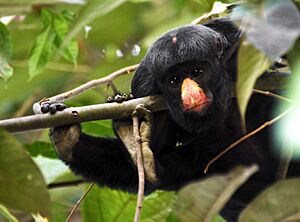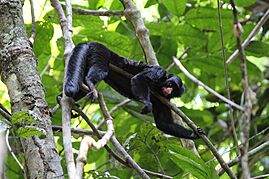White-nosed saki facts for kids
Quick facts for kids White-nosed saki |
|
|---|---|
 |
|
| Conservation status | |
| Scientific classification | |
| Genus: |
Chiropotes
|
| Species: |
albinasus
|
 |
|
| White-nosed saki range | |
The white-nosed saki (Chiropotes albinasus) is a special type of New World monkey. It is found only in the south-central Amazon rainforest in Brazil. Its name comes from how its nose looks on dead animals. In real life, their noses are actually bright pink!
These monkeys are medium-sized. They mostly eat seeds, fruit, flowers, bark, insects, and leaves. White-nosed sakis are very social animals. They live in large groups for sleeping, finding food, and traveling. Being in a group helps them stay safe from predators. They decide how to protect themselves based on how many are in their group. These sakis only have babies during certain months of the year. In 2020, they were listed as a vulnerable species. This means their population is decreasing.
Contents
Where White-Nosed Sakis Live
White-nosed sakis can live in places with big environmental changes. They can survive for a long time before needing to move. You can find them mostly in the south-east and south-central parts of the Amazon Rainforest. This area is in Brazil.
They are common in the southern Amazon. This is because they share the eastern part with another type of saki. They have also been seen near the south-western area of the Dos Marmelos River in Brazil.
What Kind of Home They Like
White-nosed sakis need habitats with lots of food. They eat similar foods to other saki monkeys. So, they usually avoid places where they have to compete for food. They mainly live in "terra firma" forests in the Amazon. These are forests that are not flooded. Here, they can easily find their favorite food: immature seeds.
They prefer primary terra firma forests. These are forests that humans have not disturbed much. Even though these forests have "poor soils," it's not a problem for sakis. They can easily form groups to find the food they need. They also like to live high up in the shaded tree canopies. This is where they spend most of their day. Sometimes, they are found in "mountain savanna forests" at high elevations, but this is less common.
How White-Nosed Sakis Look
Physical Features
The white-nosed saki has three main features. These are a beard, two tufts of hair on its head, and a long, bushy tail. These features make them easy to spot among other saki monkeys. Their bodies have black, silky fur. Their noses and lips are a reddish-pink color. Even though they have some white hairs on their noses, the skin underneath is bright pink. This makes the pink color more noticeable.
Males and females have similar features. However, females have shorter and thinner hair on their tufts and beards. Their tail is very important. When they are young, they use it to swing through trees. As adults, their tail is not used for gripping anymore. Instead, it helps them balance. They use their tail to support themselves, especially when they are eating. Their teeth look like dog teeth. These strong teeth help them break open tough foods. This includes fruits and seeds with hard shells.
Body Size and Weight
White-nosed sakis are considered medium-sized monkeys. On average, females weigh about 2.5 kg. Males weigh around 3.1 kg. Females are usually a bit lighter than males. For example, one study found females weighed 2.52 kg and males 3.17 kg.
Their head and body length combined is about 39.5 cm for females and 40.2 cm for males. Another study found females at 41.8 cm and males at 42.7 cm. Their size and weight, along with their tails for balance, make them very agile. They are known as "super climbers and leapers."
White-Nosed Saki Behaviors
Social Life
White-nosed sakis are active during the day. They do many activities by forming groups. These groups usually have 19 to 30 males and females. They have a "fission-fusion" system. This means they come together for sleeping or finding food. Then, they split up for other activities during the day.
Even though they group together, they don't communicate much. The ways they do communicate are mostly through sounds. These sounds often happen when they need to work together. For example, they use a loud, high-pitched "alarm call" to get attention or warn of danger. They use a lower pitch when they are relaxing or eating. They also use some visual signals. The main one is "tail wagging," which shows confusion. Overall, they are described as shy when it comes to social interactions.
Staying Safe from Predators
Predators greatly affect how white-nosed sakis live. This includes how they organize their groups, find food, and choose sleeping spots. Their main predators are birds of prey, like the black hawk-eagle. Because of this, they use "reactive" behaviors or "crypsis" (hiding) behaviors when attacked.
Studies have found six common ways they protect themselves. Reactive behaviors include "mobbing" (ganging up on a predator), "alarm calling," and "fleeing" (running away). Hiding behaviors include "freezing" (staying still), spreading out from each other, and hiding. After an attack, they often use alarm calls, spread out, and hide. Spreading out helps them see the predator better. It also helps them hide when they are alone. It even lets them communicate over longer distances to confuse the predator.
When hiding, they often drop from high trees to lower, denser plants. This gives them better cover. If the plants are too thick, they will move along the ground. Their anti-predator strategies change depending on how many sakis are in the group. Larger groups tend to react more strongly to threats. Males often take charge in defending and rescuing others. For example, males will spread out to protect females carrying babies. Females have also been seen helping with defense. These behaviors are typical for primates. They are "risk-sensitive animals" who change their reactions based on how serious a threat is. This helps them save energy for real dangers. Smaller primates often change their strategies more because they are at higher risk.
Reproduction and Life Cycle
Not much is known about how white-nosed sakis reproduce in the wild. Most observations were made when they were in captivity. They are "seasonal breeders," meaning they only have babies during certain times of the year. Most births happen between February and March, and again around August and September.
Pregnancy lasts about 5 months. Females usually have one baby per year. The mother does most of the parenting. She provides food and carries the baby with her everywhere.
What White-Nosed Sakis Eat
The white-nosed saki is a primary consumer. This means it eats plants. It is also a "frugivore," meaning it loves fruit. Their diet mainly includes immature seeds, fruit, flowers, bark, insects, and leaves.
Here's a breakdown of their diet:
- 36% seeds
- 54% fruit pulp and aril (the fleshy part around seeds)
- 10% bark, insects, and leaves
They prefer unripe fruit. Seeds are a very important part of their diet. They are their main source of protein. The seeds they eat are often tough and fibrous. White-nosed sakis are not picky eaters when it comes to plants. They eat over a hundred different types of plants in the Brazilian Amazon.
Protecting White-Nosed Sakis
The white-nosed saki is listed as a vulnerable species. This means it is at risk of disappearing. Several things threaten them. These include changes to their environment, like deforestation (cutting down forests). Human activities like logging, farming, and building homes destroy their habitat. Hunting is also a direct threat. Their bushy tails are used to make cleaning dusters.
Experts predict that about 30% of this species could be lost in the next 30 years. While there are some international controls on trade, more needs to be done. Better management of farming is needed because it harms their homes. It is hoped that better farming practices will prevent a projected 15% habitat loss by 2048. More research is also needed to find the best ways to help these amazing monkeys survive.
Images for kids




